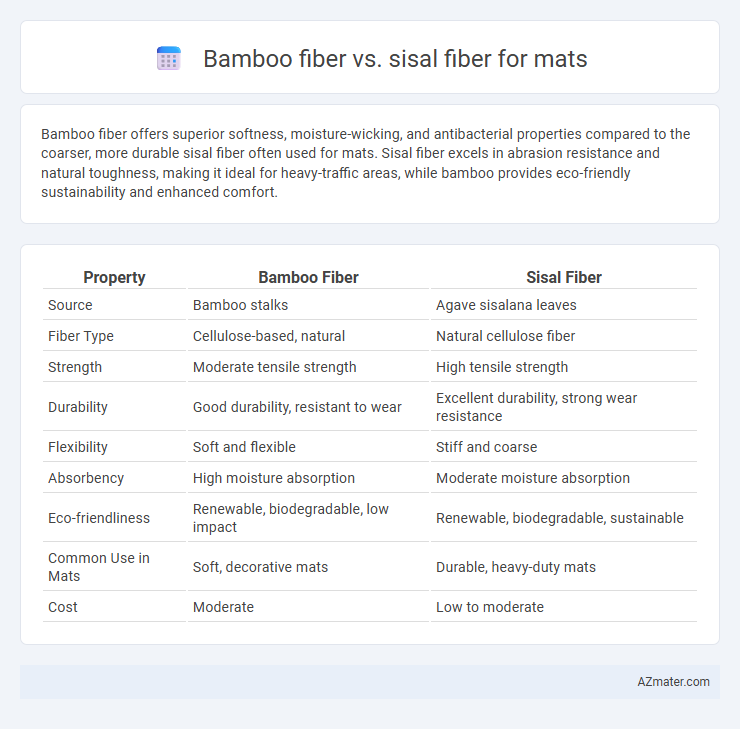Bamboo fiber offers superior softness, moisture-wicking, and antibacterial properties compared to the coarser, more durable sisal fiber often used for mats. Sisal fiber excels in abrasion resistance and natural toughness, making it ideal for heavy-traffic areas, while bamboo provides eco-friendly sustainability and enhanced comfort.
Table of Comparison
| Property | Bamboo Fiber | Sisal Fiber |
|---|---|---|
| Source | Bamboo stalks | Agave sisalana leaves |
| Fiber Type | Cellulose-based, natural | Natural cellulose fiber |
| Strength | Moderate tensile strength | High tensile strength |
| Durability | Good durability, resistant to wear | Excellent durability, strong wear resistance |
| Flexibility | Soft and flexible | Stiff and coarse |
| Absorbency | High moisture absorption | Moderate moisture absorption |
| Eco-friendliness | Renewable, biodegradable, low impact | Renewable, biodegradable, sustainable |
| Common Use in Mats | Soft, decorative mats | Durable, heavy-duty mats |
| Cost | Moderate | Low to moderate |
Introduction: Bamboo Fiber vs Sisal Fiber Mats
Bamboo fiber mats offer exceptional softness, natural antibacterial properties, and sustainable harvesting benefits, making them highly durable and eco-friendly. Sisal fiber mats stand out for their robust strength, coarse texture, and excellent moisture resistance, ideal for heavy-traffic areas and outdoor use. Both fibers provide biodegradable alternatives, but bamboo excels in smoothness and hypoallergenic qualities, while sisal delivers superior toughness and longevity.
Environmental Impact and Sustainability
Bamboo fiber offers superior sustainability due to its rapid growth rate, requiring minimal water and pesticides compared to sisal fiber, which takes longer to mature and demands more intensive land use. Both fibers are biodegradable, but bamboo cultivation contributes to higher carbon sequestration, enhancing its environmental benefits. Sisal fiber production can lead to soil degradation if not managed properly, making bamboo fiber a more eco-friendly choice for mats in terms of environmental impact and long-term sustainability.
Material Composition and Source
Bamboo fiber, derived from the cellulose of bamboo plants, offers a soft, durable, and eco-friendly material ideal for mats, known for its antibacterial and moisture-wicking properties. Sisal fiber, extracted from the leaves of the Agave sisalana plant, provides a coarse, strong, and highly resilient natural fiber commonly used in heavy-duty mats and rugs. Bamboo's rapid growth and sustainability contrast with sisal's tougher texture and durability, influencing their respective applications in mat production.
Durability and Strength Comparison
Bamboo fiber mats are known for their exceptional tensile strength and natural resistance to wear, making them highly durable for heavy foot traffic areas. Sisal fiber mats offer robust durability with high abrasion resistance and excellent tensile strength, but they may be more prone to fraying over time compared to bamboo. Both fibers provide sustainable options, yet bamboo generally outperforms sisal in longevity and strength under continuous use.
Comfort and Texture Analysis
Bamboo fiber mats offer superior softness and smooth texture due to their fine, round fibers, enhancing comfort underfoot compared to the coarser, rougher texture of sisal fiber mats. Sisal mats provide greater durability and natural stiffness, which can feel firmer but less cushioned than bamboo alternatives. The moisture-wicking properties of bamboo fibers contribute to a cooler, more breathable surface, while sisal's coarse weave tends to be more abrasive but highly resilient for high-traffic areas.
Moisture Resistance and Absorption
Bamboo fiber exhibits superior moisture resistance compared to sisal fiber, making it ideal for mats exposed to damp environments. Bamboo's natural silica content enhances its ability to repel water while maintaining breathability, unlike sisal fiber, which tends to absorb and retain moisture more readily. This moisture management in bamboo fiber contributes to longer-lasting mats with reduced risk of mold and mildew growth.
Maintenance and Cleaning Requirements
Bamboo fiber mats are highly resistant to bacteria and moisture, making them easy to clean with simple wiping or light vacuuming, ideal for low-maintenance use. Sisal fiber mats, while durable, tend to absorb moisture and stains more readily, requiring gentle brushing and spot cleaning with mild detergent to prevent damage. Bamboo mats offer superior long-term hygiene and simpler upkeep compared to the more delicate and moisture-sensitive sisal mats.
Aesthetic and Design Versatility
Bamboo fiber offers a sleek, smooth texture with a natural sheen that enhances modern and minimalist mat designs, providing a refined aesthetic appeal. Sisal fiber boasts a coarse, rustic texture that complements earthy, traditional, and bohemian styles, delivering a rich tactile experience. Both fibers support versatile design options, but bamboo's pliability allows for intricate weaving patterns, while sisal's durability suits bold, sturdy constructions.
Cost and Market Availability
Bamboo fiber mats typically offer a higher initial cost compared to sisal fiber mats due to the more complex extraction and processing methods involved, but they benefit from growing demand in eco-friendly markets that supports premium pricing. Sisal fiber mats are generally more affordable and widely available, as sisal plants grow abundantly in tropical regions and the fiber extraction process is well-established and less resource-intensive. Market availability for sisal mats is broader globally, while bamboo fiber mats are gaining traction mainly in niche markets focused on sustainability and luxury home decor.
Which Fiber is Best for Mat Making?
Bamboo fiber offers superior softness, durability, and natural antibacterial properties, making it highly suitable for comfortable and long-lasting mats. Sisal fiber is known for its coarse texture, high tensile strength, and excellent resistance to moisture, ideal for mats requiring sturdiness and outdoor use. Choosing the best fiber for mat making depends on whether softness and antibacterial features or durability and moisture resistance are prioritized.

Infographic: Bamboo fiber vs Sisal fiber for Mat
 azmater.com
azmater.com